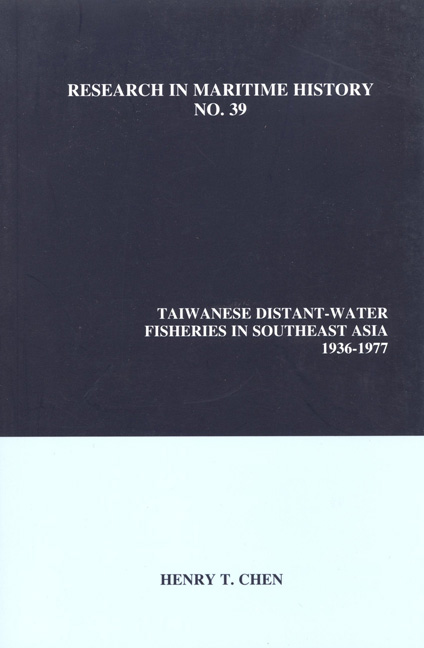Book contents
- Frontmatter
- Contents
- List of Tables
- List of Illustrations
- Notes on the Sources
- About the Author
- Acknowledgements
- Introduction
- Chapter 1 Japan and the Development of Taiwan's Fishing Industry
- Chapter 2 The Revival of the Fishing Industry in Postwar Taiwan
- Chapter 3 Kaohsiung Fishing Port and Its Fishing Ancillary Industries
- Chapter 4 The Taiwanese Fishing Industry and the Military-Political Complex
- Chapter 5 The Kaohsiung Fishing Industry and Its Ancillary Industries
- Chapter 6 The Development of Kaohsiung's Fishing Companies
- Chapter 7 Daily Lives at Sea, Fishing Zones and Politics
- Chapter 8 The Culture and Daily Life of the Kaohsiung Fishing Communities
- Chapter 9 The 1970s Crisis in the Taiwanese Fishing Industry
- Conclusion
- Appendix 1 List of Informants
- Select Bibliography
Chapter 5 - The Kaohsiung Fishing Industry and Its Ancillary Industries
- Frontmatter
- Contents
- List of Tables
- List of Illustrations
- Notes on the Sources
- About the Author
- Acknowledgements
- Introduction
- Chapter 1 Japan and the Development of Taiwan's Fishing Industry
- Chapter 2 The Revival of the Fishing Industry in Postwar Taiwan
- Chapter 3 Kaohsiung Fishing Port and Its Fishing Ancillary Industries
- Chapter 4 The Taiwanese Fishing Industry and the Military-Political Complex
- Chapter 5 The Kaohsiung Fishing Industry and Its Ancillary Industries
- Chapter 6 The Development of Kaohsiung's Fishing Companies
- Chapter 7 Daily Lives at Sea, Fishing Zones and Politics
- Chapter 8 The Culture and Daily Life of the Kaohsiung Fishing Communities
- Chapter 9 The 1970s Crisis in the Taiwanese Fishing Industry
- Conclusion
- Appendix 1 List of Informants
- Select Bibliography
Summary
This chapter will examine the relationship between the Kaohsiung fishing industry and the ancillary industries. To make this manageable, I will limit my discussion to six of the most important ancillary industries: ice manufacturing, trucking, shipbuilding, equipment supply, security and stevedoring. The first three were well organized and financially independent of the fishing companies. When disputes arose, the government did not always side with the fishing industry. On the other hand, fishing equipment suppliers were small retail businesses or household operations which produced and sold rope, nets, cables and other fishing gear, while security companies and stevedoring firms comprised poor labourers who eked out a barely tolerable livelihood. Both the labourers and the small business owners had little market power or political clout and were not in as strong a bargaining position as the large shipyards, icemakers and transport companies. By examining the interactions between the fishing companies and these other industries, I will demonstrate the behavioural characteristics of fishing vessel owners and analyze the manner in which they dealt with threats from other industries with comparable social influence and financial strength, as well as people from other social strata like the equipment suppliers, stevedores and security companies.
The “War” between the Vessel Owners and Ice Manufacturers
The first group with which the fishing industry fought fiercely in the early postwar era was the ice manufacturers. In the 1950s, refrigeration equipment was not yet widely used on fishing vessels, so having a reliable and reasonably priced ice supply was critically important. Fortunately, neither the price nor supply of ice were major issues. The situation changed dramatically, however, when ice manufacturers in Nanfang'ao unexpectedly increased prices without governmental authorization in May 1958.
The rise in ice prices at Nanfang'ao, a fishing port in the northeastern corner of Taiwan (see figure 5.1), triggered nationwide price fluctuations. The Ice Manufacturers Association of Taiwan Province ([Taiwansheng Jhihbingye Gonghuei], or IM ATP) took similar concerted action and encouraged its members (except those in Taipei) to follow Nanfang'ao's example after 10 May. As a result, the price of ice for the fishing industry soared from NT $15.8 to NT $18 for 300 pounds; NT $17.4 to NT $19.8 for 330 pounds; and NT $21 to NT $24 for 400 pounds.
- Type
- Chapter
- Information
- Publisher: Liverpool University PressPrint publication year: 2009



